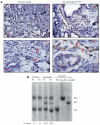Loss of one Tgfbr2 allele in fibroblasts promotes metastasis in MMTV: polyoma middle T transgenic and transplant mouse models of mammary tumor progression
- PMID: 21374085
- PMCID: PMC3373018
- DOI: 10.1007/s10585-011-9373-0
Loss of one Tgfbr2 allele in fibroblasts promotes metastasis in MMTV: polyoma middle T transgenic and transplant mouse models of mammary tumor progression
Abstract
Accumulation of fibroblasts is a phenomenon that significantly correlates with formation of aggressive cancers. While studies have shown that the TGF-β signaling pathway is an important regulator of fibroblast activation, the functional contribution of TGF-β signaling in fibroblasts during multi-step tumor progression remains largely unclear. In previous studies, we used a sub-renal capsule transplantation model to demonstrate that homozygous knockout of the Tgfbr2 gene (Tgbr2(FspKO)) enhanced mammary tumor growth and metastasis. Here, we show for the first time a significant role for loss of one Tgfbr2 allele during multi-step mammary tumor progression. Heterozygous deletion of Tgfbr2 in stromal cells in MMTV-PyVmT transgenic mice (PyVmT/Tgfbr2(hetFspKO) mice) resulted in earlier tumor formation and increased stromal cell accumulation. In contrast to previous studies of Tgbr2(FspKO) fibroblasts, Tgfbr2(hetFspKO) fibroblasts did not significantly increase tumor growth, but enhanced lung metastasis in PyVmT transgenic mice and in co-transplantation studies with PyVmT mammary carcinoma cells. Furthermore, Tgfbr2(hetFspKO) fibroblasts enhanced mammary carcinoma cell invasiveness associated with expression of inflammatory cytokines including CXCL12 and CCL2. Analyses of Tgbr2(FspKO) and Tgfbr2(hetFspKO) fibroblasts revealed differences in the expression of factors associated with metastatic spread, indicating potential differences in the mechanism of action between homozygous and heterozygous deletion of Tgfbr2 in stromal cells. In summary, these studies demonstrate for the first time that loss of one Tgfbr2 allele in fibroblasts enhances mammary metastases in a multi-step model of tumor progression, and demonstrate the importance of clarifying the functional contribution of genetic alterations in stromal cells in breast cancer progression.
Figures







Similar articles
-
Loss of TGF-beta type II receptor in fibroblasts promotes mammary carcinoma growth and invasion through upregulation of TGF-alpha-, MSP- and HGF-mediated signaling networks.Oncogene. 2005 Jul 28;24(32):5053-68. doi: 10.1038/sj.onc.1208685. Oncogene. 2005. PMID: 15856015 Free PMC article.
-
Loss of transforming growth factor-beta signaling in mammary fibroblasts enhances CCL2 secretion to promote mammary tumor progression through macrophage-dependent and -independent mechanisms.Neoplasia. 2010 May;12(5):425-33. doi: 10.1593/neo.10200. Neoplasia. 2010. PMID: 20454514 Free PMC article.
-
Enhanced hepatocyte growth factor signaling by type II transforming growth factor-beta receptor knockout fibroblasts promotes mammary tumorigenesis.Cancer Res. 2007 May 15;67(10):4869-77. doi: 10.1158/0008-5472.CAN-06-3381. Epub 2007 May 10. Cancer Res. 2007. PMID: 17495323
-
Modeling human breast cancer metastasis in mice: maspin as a paradigm.Histol Histopathol. 2003 Jan;18(1):201-6. doi: 10.14670/HH-18.201. Histol Histopathol. 2003. PMID: 12507299 Review.
-
Insights from transgenic mouse models of PyMT-induced breast cancer: recapitulating human breast cancer progression in vivo.Oncogene. 2021 Jan;40(3):475-491. doi: 10.1038/s41388-020-01560-0. Epub 2020 Nov 24. Oncogene. 2021. PMID: 33235291 Free PMC article. Review.
Cited by
-
TGF-β Negatively Regulates CXCL1 Chemokine Expression in Mammary Fibroblasts through Enhancement of Smad2/3 and Suppression of HGF/c-Met Signaling Mechanisms.PLoS One. 2015 Aug 7;10(8):e0135063. doi: 10.1371/journal.pone.0135063. eCollection 2015. PLoS One. 2015. PMID: 26252654 Free PMC article.
-
TGFβ signaling in myeloid cells regulates mammary carcinoma cell invasion through fibroblast interactions.PLoS One. 2015 Jan 28;10(1):e0117908. doi: 10.1371/journal.pone.0117908. eCollection 2015. PLoS One. 2015. PMID: 25629162 Free PMC article.
-
Deletion of TGF-β signaling in myeloid cells enhances their anti-tumorigenic properties.J Leukoc Biol. 2012 Sep;92(3):641-51. doi: 10.1189/jlb.1211639. Epub 2012 Jun 8. J Leukoc Biol. 2012. PMID: 22685318 Free PMC article.
-
CCR2 Chemokine Receptors Enhance Growth and Cell-Cycle Progression of Breast Cancer Cells through SRC and PKC Activation.Mol Cancer Res. 2019 Feb;17(2):604-617. doi: 10.1158/1541-7786.MCR-18-0750. Epub 2018 Nov 16. Mol Cancer Res. 2019. PMID: 30446625 Free PMC article.
-
Dualism of FGF and TGF-β Signaling in Heterogeneous Cancer-Associated Fibroblast Activation with ETV1 as a Critical Determinant.Cell Rep. 2019 Aug 27;28(9):2358-2372.e6. doi: 10.1016/j.celrep.2019.07.092. Cell Rep. 2019. PMID: 31461652 Free PMC article.
References
-
- Desmouliere A, Guyot C, Gabbiani G. The stroma reaction myofibroblast: a key player in the control of tumor cell behavior. Int J Dev Biol. 2004;48(5-6):509–517. - PubMed
-
- Kalluri R, Zeisberg M. Fibroblasts in cancer. Nat Rev Cancer. 2006;6(5):392–401. - PubMed
-
- Sakakura T, Sakagami Y, Nishizuka Y. Accelerated mammary cancer development by fetal salivary mesenchyma isografted to adult mouse mammary epithelium. J Natl Cancer Inst. 1981;66(5):953–959. - PubMed
Publication types
MeSH terms
Substances
Grants and funding
LinkOut - more resources
Full Text Sources

